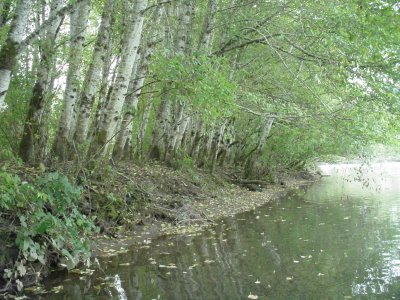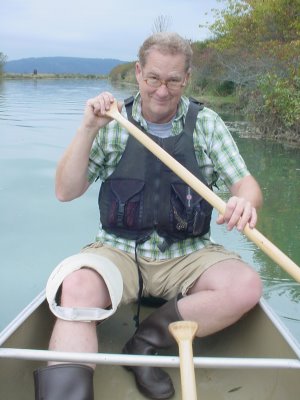 Our paddle at the Skokomish River Delta occurred at very high tide on a heavily overcast day. That made for smooth gliding over still water. It was a great paddle because of the intimacy of the channel, the meandering pathways upriver, and the drama of the delta, with its resident seal population and shorebirds. The Hood Canal has transient killer whales that come in for the seals every year.
Our paddle at the Skokomish River Delta occurred at very high tide on a heavily overcast day. That made for smooth gliding over still water. It was a great paddle because of the intimacy of the channel, the meandering pathways upriver, and the drama of the delta, with its resident seal population and shorebirds. The Hood Canal has transient killer whales that come in for the seals every year. This area on the Hood Canal is stressed due to poorly dissolved oxygen content in the water (hypoxia), and that impacts on the fish and the mammals that inhabit the water. Studies are in progress to determine what has caused the poor oxygen levels, whether due to chum salmon carcasses from commercial fisheries or due to toxins from shoreline residences. There is a neighborhood program that alerts homeowners to proper sewage and garbage removal practices, so toxins will not enter the water.
While we glided along, we noticed that salmon carcases floated in the water, due to the end of spawning. These were some huge fish, some over 3 feet long, with gaping mouths and mottled skin. Skeletons lay on the bottom of the water, picked completely clean, and a few returning salmon glided under our canoe as we headed upriver. They move very slow and have no instinct for self-preservation as they continue upriver. There is something sad and solitary about them, so ragged and spent. One has to imagine the grand life they once lived as they migrated out to the ocean to fulfill their life cycle.
The tribal fishermen had gill nets along the shoreline, most of them emptied and pulled into a pile along the shore. We noticed one large gill-net that still had trapped dead salmon caught in the lines. Sediment had covered parts of them, as if the net had not been pulled in a long time. Little shelters - camps - lined parts of the shoreline, where families had spent part of the summer pulling in fish. Tarps were spread over poles, and buckets, old clothes, and tincans still remained in camp. Fishline, with bobbins and lures hung from snags on overhead branches and also swayed down under the water where they'd been hooked on submerged debris. There is the impression that this area is busy during the fishing season. Yet now it was just filled with fellow kayakers and canoeists, who give scant attention to the ecosystem and the economy built into the area. They just want to explore and appreciat the scenery.
This is a line of birch trees along private property, perhaps to hold in the riverbank.
 Rarely do you see this type of maintenance along this waterway, as everything is left in its natural state, with an abundance of wild rose and other flowering shrubs. As we paddled along, we noticed old apple and pear trees along the riverbank, and stands of blackberry and current.
Rarely do you see this type of maintenance along this waterway, as everything is left in its natural state, with an abundance of wild rose and other flowering shrubs. As we paddled along, we noticed old apple and pear trees along the riverbank, and stands of blackberry and current.  And this is one of the little cabins along the entrance to the delta, near our put-in place. It is on pilings, extending up over the water during high tide.
And this is one of the little cabins along the entrance to the delta, near our put-in place. It is on pilings, extending up over the water during high tide.This is my trusty paddler and traveling companion, who raids my goodie box filled with cashews, pretzels, and graham crackers. However, he is also most considerate of wildlife.
 When I say 'lets get closer', he always stays at a safe distance. When I wanted to get closer to a gathering of sea lions and seals basking in the sun on a sandbank, he refused. Too dangerous and invasive, he said. However, I filmed them with a zoom lens, and watched them bobbing up and down in the water - about 30 of them checking us out. Then, there was a barrage of loud splashes where the sea lions banged the water, letting us know to stay away - or else! They made the deepest growling sounds, and we knew to keep on paddling.
When I say 'lets get closer', he always stays at a safe distance. When I wanted to get closer to a gathering of sea lions and seals basking in the sun on a sandbank, he refused. Too dangerous and invasive, he said. However, I filmed them with a zoom lens, and watched them bobbing up and down in the water - about 30 of them checking us out. Then, there was a barrage of loud splashes where the sea lions banged the water, letting us know to stay away - or else! They made the deepest growling sounds, and we knew to keep on paddling.